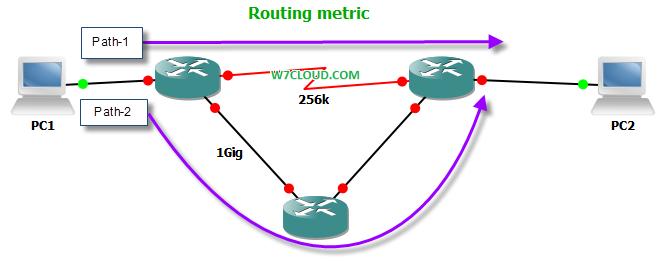Router metrics are metrics used by a router to make routing decisions. It is typically one of many fields in a routing table.
Metrics are used to determine whether one route should be chosen over another. The routing table stores possible routes, while link-state or topological databases may store all other information as well. For example, Routing Information Protocol uses hopcount (number of hops) to determine the best possible route. The route will go in the direction of the gateway with the lowest metric. The direction with the lowest metric can be a default gateway.
Router metrics can contain any number of values that help the router determine the best route among multiple routes to a destination. A router metric typically based on information like path length, bandwidth, load, hop count, path cost, delay, Maximum Transmission Unit (MTU), reliability and communications cost.
Examples
A Metric can include:
- measuring link utilisation (using SNMP)
- number of hops (hop count)
- speed of the path
- packet loss (router congestion/conditions)
- latency (delay)
- path reliability
- path bandwidth
- throughput [SNMP - query routers]
- load
- MTU
In EIGRP, metrics is represented by an integer from 0 to 4,294,967,295 (The size of a 32-bit integer). In Microsoft Windows XP routing it ranges from 1 to 9999.
A Metric can be considered as:
- additive - the total cost of a path is the sum of the costs of individual links along the path,
- concave - the total cost of a path is the minimum of the costs of individual links along the path,
- multiplicative - the total cost of a path is the product of the costs of individual links along the path.
A survey of routing metrics can be found here.
Service Level Metrics
Router metrics are metrics used by a router to make routing decisions. It is typically one of many fields in a routing table.
Router metrics can contain any number of values that help the router determine the best route among multiple routes to a destination. A router metric typically based on information like path length, bandwidth, load, hop count, path cost, delay, Maximum Transmission Unit (MTU), reliability and communications cost.
Availability
The availability of a computer network (or an individual service) may be expressed using the notation hh/d/ww. For a 24 hour service, seven days a week, available all year around, this would be expressed 24/7/52 (where the 52 stands for the number of weeks in a year). Service providers usually express that a service will be available for a percentage of this time.
To calculate the availability of a service expressed in this format, you need to do the following calculation:
98% availability on 24/7/52
- Multiply 24 hours per day by 7 days per week by 52 weeks per year = 8736 hours per year
- Find 98% of the hours per year = 8736 * 98 / 100 = 8561.28 hours guaranteed
You can then deduce how many full hours/days per year the service can be unavailable before the supplier is in breach of their Service Level Agreement. In this example, 8736 (hours) - 8561 (hours) = 175 hours (or around 7.3 days).

